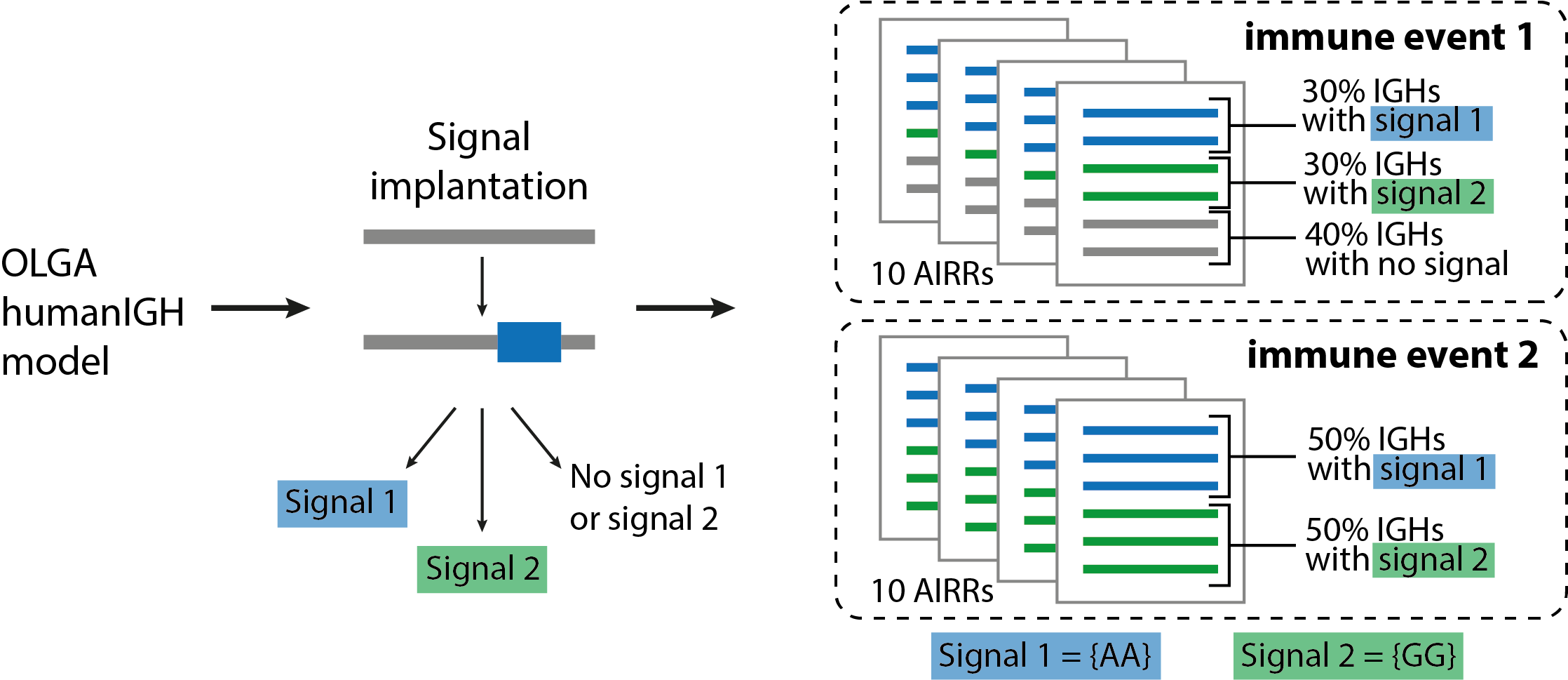How to use LIgO for repertoire-level simulation¶
Simulation of BCR repertoires labeled with two immune events¶
In this quickstart tutorial, we will generate a dataset of 20 BCR repertoires, with each repertoire containing 6 BCRs, as follows (see the illustration below):
10 repertoires labeled as immune event 1 and consist of 30% BCRs with signal 1 and 30% BCRs with signal 2;
10 repertoires labeled as immune event 2 and consist of 50% BCRs with signal 1 and 50% BCRs with signal 2.
We define signal 1 and signal 2 as follows (see the illustration below):
Signal 1 is composed of a 2-mer {AA};
Signal 2 is composed of a 2-mer {GG}.
Signal-specific BCRs will be generated using the signal implantation strategy, where any implanting position is allowed, and the default OLGA model (humanIGH). If you also want to report the generation probabilities (pgen) of the simulated receptors according to the default OLGA humanTRB model, set the export_p_gens parameter to true. Please keep in mind that pgen evaluation may take time.

Step 1: YAML specification¶
LIgO simulation starts with defining the YAML file with the simulation parameters. First, we define the immune signals 1 and 2 in the definitions section. You can read more about the yaml file parameters in YAML specification.
definitions:
motifs:
motif1:
seed: AA
motif2:
seed: GG
signals:
signal1:
motifs: [motif1]
signal2:
motifs: [motif2]
Second, we define the immune events and the repertoire parameters, such as the number of repertoires and the number of BCRs in the repertoire, in the simulations section. You can read more about the yaml file parameters in YAML specification.
simulations:
sim1:
is_repertoire: true
paired: false
sequence_type: amino_acid
simulation_strategy: Implanting
remove_seqs_with_signals: true # remove signal-specific AIRs from the background
sim_items: # group of AIRs with the same parameters
AIRR1:
immune_events:
ievent1: True
ievent2: False
signals: {signal1: 0.3, signal2: 0.3}
number_of_examples: 10
is_noise: False
receptors_in_repertoire_count: 6
generative_model:
chain: heavy
default_model_name: humanIGH
model_path: null
type: OLGA
AIRR2:
immune_events:
ievent1: False
ievent2: True
signals: {signal1: 0.5, signal2: 0.5}
number_of_examples: 10
is_noise: False
receptors_in_repertoire_count: 6
generative_model:
chain: heavy
default_model_name: humanIGH
model_path: null
type: OLGA
Finally, we define the technical parameters of the simulation in the instructions section. You can read more about the yaml file parameters in YAML specification.
instructions:
my_sim_inst:
export_p_gens: false
max_iterations: 100
number_of_processes: 4
sequence_batch_size: 1000
simulation: sim1
type: LigoSim
Here is the complete YAML specification for the simulation:
definitions:
motifs:
motif1:
seed: AA
motif2:
seed: GG
signals:
signal1:
motifs: [motif1]
signal2:
motifs: [motif2]
simulations:
sim1:
is_repertoire: true
paired: false
sequence_type: amino_acid
simulation_strategy: Implanting
remove_seqs_with_signals: true # remove signal-specific AIRs from the background
sim_items: # groups of AIRs with the same parameters
AIRR1:
immune_events:
ievent1: True
ievent2: False
signals: {signal1: 0.3, signal2: 0.3}
number_of_examples: 10
is_noise: False
receptors_in_repertoire_count: 6
generative_model:
chain: heavy
default_model_name: humanIGH
model_path: null
type: OLGA
AIRR2:
immune_events:
ievent1: False
ievent2: True
signals: {signal1: 0.5, signal2: 0.5}
number_of_examples: 10
is_noise: False
receptors_in_repertoire_count: 6
generative_model:
chain: heavy
default_model_name: humanIGH
model_path: null
type: OLGA
instructions:
my_sim_inst:
export_p_gens: false
max_iterations: 100
number_of_processes: 4
sequence_batch_size: 1000
simulation: sim1
type: LigoSim
Step 2: Running LIgO¶
After saving the yaml specification to a file (e.g., quickstart_repertoire.yaml), you can proceed with the analysis by following these steps:
Activate the virtual environment where you have installed LIgO, for example
source ligo_env/bin/activate
Navigate to the directory where the yaml specification (quickstart_repertoire.yaml) was saved.
Execute the following command:
ligo quickstart_repertoire.yaml quickstart_output_repertoire
All results will be located in quickstart_output_repertoire. Note that the output folder (quickstart_output_repertoire) should not exist prior to the run.
Step 3: Understanding the output¶
The folder quickstart_output_repertoire/my_sim_inst/exported_dataset/airr/ contains the simulation output as the metadata.csv file and the repertoires folder.
Metadata file¶
metadata.csv is a table where each row describes one repertore, see below a metadata file example for the quickstart repertoire-level simulation
subject_id |
filename |
repertoire_id |
ievent1 |
ievent2 |
signal1 |
signal2 |
sim_item |
identifier |
|---|---|---|---|---|---|---|---|---|
subject_0 |
e5af5d574fc84140bb54bf0fa81245ea.tsv |
e5af5d574fc84140bb54bf0fa81245ea |
TRUE |
FALSE |
TRUE |
TRUE |
AIRR1 |
e5af5d574fc84140bb54bf0fa81245ea |
subject_1 |
47799dfcb42d4c1ba3e01d3ff2943cdb.tsv |
47799dfcb42d4c1ba3e01d3ff2943cdb |
FALSE |
TRUE |
TRUE |
TRUE |
AIRR2 |
47799dfcb42d4c1ba3e01d3ff2943cdb |
… |
… |
… |
… |
… |
… |
… |
… |
… |
Repertoires folder¶
repertoires folder contains tsv files, where one file corresponds to one repertoire. The repertoire filenames are listed in the metadata.csv file. In the repertoire tsv file, each row represents one AIR. Some of the output columns are shown in the table below.
Since the AIRRs were simulated using signal implantation, the output repertoire file contains several additional columns:
original_sequence: AIR before signal implantation
original_p_gen: p_gen of an AIR before signal implantation
productive |
v_call |
j_call |
junction_aa |
signal1 |
signal2 |
signal1_position |
signal2_position |
|---|---|---|---|---|---|---|---|
F |
IGHV1-2*02 |
IGHJ4*01 |
CARGWQHSSGWTPPGSDAA |
1 |
0 |
m00000000000000000100 |
m00000000000000000000 |
F |
IGHV3-23*01 |
IGHJ4*01 |
CAAAANVDYW |
1 |
0 |
m00100000000 |
m00000000000 |
F |
IGHV1-18*01 |
IGHJ6*01 |
CAKGTHGGFTIFGVVIFPEVINVSGTYYYYMDVW |
0 |
1 |
m00000000000000000000000000000000000 |
m00000010000000000000000000000000000 |
… |
… |
… |
… |
… |
… |
… |
… |
Next steps¶
For a quickstart guide on receptor-level simulation see How to use LIgO for receptor-level simulation.
Other tutorials for how to use LIgO can be found under Tutorials.
You can find more information about yaml parameters in YAML specification.